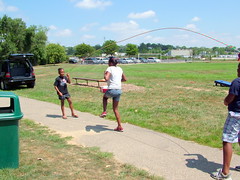
DSCF0745
Originally uploaded by jalenaaron
Pay attention to your framing (what you see in the viewfinder). There are a few distracting elements in this photo that could have been eliminated; minivan and trash bin. Moving in closer and rotating your lens to the right would have cut out these distractions. Rotating your lens to the right would also have included the rope twirler on the right. The subject here is the girl jumping rope, we'd like to see the expression on her face as she jumps rope, so positioning yourself where she faces the camera would have been better.
Photo Chick
